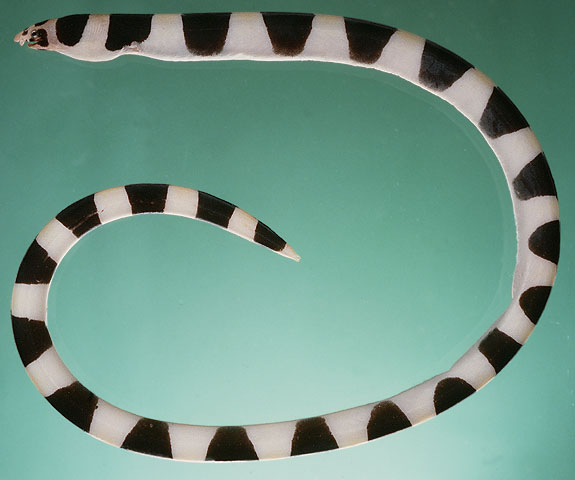| Ophichthidae (Snake eels), subfamily: Ophichthinae |
| 66 cm TL (male/unsexed) |
|
reef-associated; brackish; marine; depth range 0 - 10 m |
| Indo-Pacific: East Africa to the Hawaiian, Marquesan, and Mangaréva islands, north to southern Japan, south to northern New South Wales, Australia. Also recorded from Southeast Atlantic: South Africa (Ref. 3972). |
|
Dorsal spines (total): 0-0; Dorsal soft rays (total): 0-0; Anal spines: 0-0; Anal soft rays: 0-0; Vertebrae: 162-171. White to yellow with 25-30 black saddles (Ref. 3972).
Description: Characterized by head length 12-15 in TL; body depth 35-60 in TL; preanal length 2.1-2.3 in TL; dorsal fin origin above or slightly posterior to gill opening; relatively large eye above middle of gape; intermaxilla with about five nearly recumbent, small canine teeth in ventral groove under snout; small and uniserial remaining teeth in jaws; teeth in vomer absent or occasionally with 1-3 small teeth (Ref. 90102). |
| Occurs in sandy areas and seagrass beds of both lagoon and seaward reefs. Uses its stiff pointed tail to rapidly burrow backwards into the sand when frightened (Ref. 37816). Benthic (Ref. 58302). Feeds on sand-dwelling fishes and crabs and prawns. Sometimes fully exposed when searching for prey (Ref. 30874). Rises to the surface to spawn (Ref. 37816). |
|
Least Concern (LC); Date assessed: 24 November 2020 Ref. (130435)
|
| harmless |
Source and more info: www.fishbase.org. For personal, classroom, and other internal use only. Not for publication.

